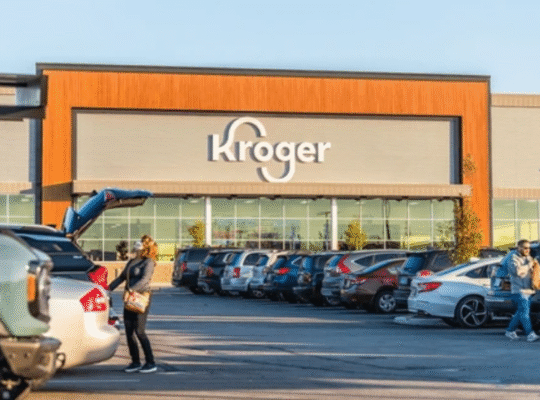Introduction
In the dynamic landscape of grocery retail, change is the handy constant. But while a giant like Kroger—the biggest supermarket chain in the United States—announces that it’ll close 60 stores over the next 18 months, it captures countrywide attention. These closures, spanning a couple of states, replicate a strategic recalibration aimed toward improving operational efficiency and profitability.
This article examines why Kroger made this bold choice, explores the places affected, highlights how employees and communities are supported, and describes what this indicates for buyers and traders. We’ll additionally provide a comprehensive listing of store closures and answer frequently requested questions that will help you navigate this substantial shift.
Why Kroger Is Closing 60 Stores
Kroger’s management has emphasised that these closures aren’t a retreat but a reallocation of resources. In a recent internal verbal exchange, agency leaders shared that a few of the affected locations have been working with declining foot traffic and increasing operational costs for several years. By disposing of these high-expense, low-performance stores, Kroger believes it could acquire healthier profit margins across the board. The intention is not most effective to preserve its market position, but to sharpen its recognition of evolving purchaser alternatives, such as an increasing shift towards virtual buying and domestic delivery options. Rather than spreading resources skinny, the organisation goals to double down on stores and areas that display strong performance and destiny capability. Kroger’s period in-between CEO has emphasized that this circulation is a part of a broader method to streamline performance and free up long-term costs. The goal is easy yet profound: identify underperforming places, reallocate resources to more potent markets, and reinvest savings into store upgrades, e‑commerce enlargement, and new store development.
A first‑area impairment rate of $a hundred million underscores the gravity of the choice; however, Kroger tasks modest financial benefits. By moving income from weaker retailers to nearby stronger ones—and modernizing shops and digital systems—the agency expects to emerge greater agile and centered.
Despite these closures, Kroger stays financially sturdy. First‑region sales were $ 1.1 billion, with robust overall performance in pharmacy, e‑trade, and sparkling foods. These healthful segments will guide reinvestment efforts, ensuring Kroger remains applicable in an evolving retail market.
Which States Will Be Impacted
Though the total listing of closures hasn’t been launched, media reviews and union records have diagnosed precise states and communities affected. Texas leads the wave of bulletins with at least 3 Kroger closures in McKinney, Dickinson, and The Woodlands. Other states with confirmed or rumored closures include Georgia, Illinois, Indiana, Kentucky, Louisiana, Tennessee, Virginia, and West Virginia.
Major manufacturers such as Mariano’s, a Kroger subsidiary in Chicago, are also affected, with at least three suburban locations last this summer. Additionally, round seven Harris Teeter devices—a Kroger-owned chain—are set to shut by means of August, with closures in places like Abingdon, Virginia, and Kingsport, Tennessee.
These changes represent about 2–five% of Kroger’s whole store community, impacting each city center and smaller groups throughout numerous regions. In addition to shop closures, there’s a hypothesis that Kroger may additionally reduce its funding in certain local distribution centers. Although no legitimate announcements have been made on the delivery chain aspect, industry experts accept as true with that as shops cut back in specific areas, logistical consolidation might also follow. This circulation ought to have further ripple effects on transportation contracts, warehouse staffing, and dealer relationships. As part of this adjustment, Kroger might also be searching to optimize its delivery routes and adopt centralized fulfillment strategies, ensuring that the closing stores perform more fee-effectively and effectively.
Confirmed Closures: What We Know So Far
Based on verified media reports and union information, here’s a developing list of the Kroger stores set to shut in 2025:
McKinney, Texas – 1707 W. University Dr.
Dickinson, Texas – closed June 10 (after 45 years)
The Woodlands, Texas – closed May 6
Abingdon, Virginia – to shut down on September 19
Kingsport, Tennessee – predicted closure by using September 19
Three Mariano’s places in suburban Chicago – this summer time
Seven Harris Teeter stores – to close between20 August 4 and
This listing will evolve as Kroger releases extra info. These confirmed closures are spread across more than one state, reinforcing the scale of the plan.
How Kroger Is Supporting Affected Employees
Kroger has stated that employees at remaining stores may be supplied positions at different nearby locations. This dedication is aimed at easing transitions for the body of workers and retaining experienced expertise. Transition applications and transfer alternatives are being made to be had, even though specifics vary by use. In many areas, Kroger is working carefully with staff improvement businesses to offer education and reskilling programs. These projects are designed to help displaced personnel qualify for roles in virtual achievement, pharmacy offerings, and managerial tracks in the Kroger ecosystem. The enterprise recognizes that the talent set required in cutting-edge grocery retail is evolving, and it pursues making investments in the long-term career paths of its personnel, not just brief-term process replacements.
Local unions have been advocates for employees, expressing concerns about task balance and its effect on groups. In many cases, union involvement has added petitions to try to hold stores open, in particular in areas where Kroger is the nearest meal provider.
Kroger’s reinvestment plan indicates that a few displaced pals may additionally discover roles in new stores or preservation initiatives, aligning community issues with long-term incentives.
What This Means for Consumers
For consumers, adjustments may also suggest a longer journey to their nearest Kroger or affiliated shop. In some communities, this may reduce access to clean meals and pharmacy offerings.
Kroger argues that clients will benefit from step-forward reports at nearby U.S. locations. The enterprise plans to channel resources into the retail, store layout, product assortment, and online services like Instacart, along with quicker transport options.
Still, community response to closures—like in Abingdon, VA, and Kingsport, TN—raises crucial questions about food get admission to and social impact. Kroger’s partnerships with neighborhood governments and nonprofits might be essential in addressing gaps and making sure that everyone has access to services is particularly in rural towns in which Kroger can also be the only full-carrier grocery provider. In such areas, residents fear that closures should make contributions to the growth of food deserts—geographical areas with restrained get entry to to fresh, affordable, and nutritious meals. To deal with this, network leaders and nonprofit partners are encouraging Kroger to consider alternative carrier models consisting of mobile markets, pop-up clean produce centers, or collaborations with regional co-ops.
Reinvestment and Future Growth
Despite the closures, Kroger is signaling growth in other regions. At least 30 new store openings will manifest in 2025, with plans to boost up boom in high‑capability markets in 2026 and beyond.
Investments are also flowing toward e‑trade and fitness offerings. Kroger continues to recruit its digital talents, enhance pharmacy attain, and introduce sparkling food innovations. The repurposing of savings from savings into these priorities underscores a ahead‑searcforward-lookingtered on sustainable growth. Kroger additionally plans to make investments heavily in synthetic intelligence and predictive analytics to optimize inventory control, reduce food waste, and customize the purchasing experience. These innovations are expected to increase efficiency and improve client pride in the closing and newly constructed stores. By leveraging modern-day technology, the business enterprise aims to compete greater successfully with both conventional supermarkets and digital-first retailers.
Real‑World Impact: Community and Union Response
Communities like Abingdon and Kingsport have voiced their worries publicly. Petitions and nearby advocacy groups have emerged to request Kroger’s reconsideration. Union leaders stress that many affected stores serve as essential grocery and pharmacy hubs, especially in rural areas.
These reactions mirror a broader communicate about retail consolidation, food deserts, and social obligation. Kroger has pledged to provide transitional assistance but faces growing strain to ensure equitable effects—not just profitability—mainly in underserved regions.
Navigating the Transition: Advice for Shoppers and Employees
If you’re a consumer at a closing location:
Consider exploring nearby Kroger-owned banners like Fred Meyer, King Soopers, Smith’s, or Mariano’s. Many offer comparable products and services.
Take advantage of Kroger’s shop locator and cell app to find the nearest shop, check its commencing hours, and discover new service features like quicker delivery and curbside pickup.
Sign up for promotional alerts, as Kroger plans to introduce more advantageous packages to attract and hold customers throughout the transition.
If you’re an employee at a closing, keep:
Reach out to your manager and HR consultant to recognize your relocation options. In addition to internal process placements, Kroger is working with 1/3-celebration staffing corporations to become aware of outside roles for those who choose not to transfer within the company. This collaborative approach is designed to decrease disruption and permit personnel to make transitions that align with their dreams, whether inside or outdoor the Kroger network. The intention, in step with Kroger management, is to deal with every affected employee with dignity and admiration during the process.
Explore switch opportunities in close by shops or new openings.
Update your resume and don’t forget to apply internally to roles in developing regions, which include e‑trade, pharmacy, and customer support.
Long‑Term Implications for Kroger and Retailers
The closure of 60 stores is huge; however, Kroger’s reinvestment strategy suggests a pivot from scale for the sake of scale, towards agility, precision, and service best. This signals a broader retail fashion: optimizing portfolios, focusing on worthwhile locations, and embracing virtual innovation.
For competitors, Kroger’s transformation might also act as a model and a task. Those retailers that keep growing old, underperforming shops might also face comparable pressures. Meanwhile, Kroger’s investments in modernization and consumer expectations should enhance industry standards. While the closures raise understandable issues, they also reflect an evolving truth in American retail: not all locations can remain feasible in a rapidly moving economy. Changing demographics, improved online purchasing, and post-pandemic patron behavior have altered the way human beings interact with grocery chains. For Kroger, this change provides each a challenge and an opportunity to steer the destiny of food retail by embracing innovation, network engagement, and consumer experience in the same measure. The strategic refocus is an assertion of motive that Kroger intends to guide, not follow, in shaping the modern supermarket experience.
Frequently Asked Questions (FAQs)
Q1. Why is Kroger closing 60 shops in 2025?
A: Kroger’s ambitions to streamline its operations by last underperforming stores and redirecting resources to more potent markets. The company plans to reinvest financial savings into technology, shop renovations, new openings, and e‑commerce to improve ordinary performance and profitability.
Q2. Which states might be affected?
A: Confirmed and reported closures are occurring in Texas, Virginia, Tennessee, Georgia, Illinois, Indiana, Kentucky, Louisiana, and West Virginia. Kroger has not released a full, legitimate listing; however, national and local reporting continues to discover the locations.
Q3. Will employees lose their jobs?
A: Kroger has devoted to providing positions at nearby shops to all affected employees. Transition options consist of transfers or redeployment in new or renovated stores, although implementation might also vary by means of place.
Q4. What services might be affected for customers?
A: Customers may additionally revel in longer journey distances and modifications to buying patterns. However, Kroger plans to enhance last stores, release new ones, and amplify digital offerings, which include Instacart, curbside pickup, and pharmacy get admission to to maintain convenience.
Q5. How will the network reply?
A: Local petitions and union-led efforts have emerged in affected areas like Abingdon and Kingsport. Concerns revolve around process losses and decreased get right of entry to to clean meals and important offerings. Kroger has pledged to guide and implement transitional measures but maintains to stand network strain.
Q6. Will Kroger open new shops?
A: Yes. Kroger plans to open at least 30 new stores in 2025 and increase in high-ability areas in 2026. The reinvested savings will assist these initiatives at the side of keeping modernizations and virtual enhancements.
Q7. How does this affect Kroger’s economic outlook?
A: Kroger will take a one-time $ hundred million impairment fee, but anticipates modest monetary advantages over the years. The corporation remains financially sound, with robust overall performance in pharmacy, e-trade, and clean foods, providing a stable platform for reinvestment.
Q8. What can buyers do now?
A: Shoppers should affirm the reputation of nearby shops, research close-by Kroger-owned stores, and discover improved offerings like delivery and pickup. Signing up for loyalty notifications and checking upcoming keep openings or renovations can help maintain a steady buying experience.
Disclaimer
Created with the Synergy of AI innovation and through research, this article is intended to offer clear, accurate, and actionable insights. Each point has been double-checked to ensure it adds genuine value to your knowledge base. Our mission is to guide you with reliable, easy-to-understand information. Enjoy your reading experience and continue exploring new ideas!






